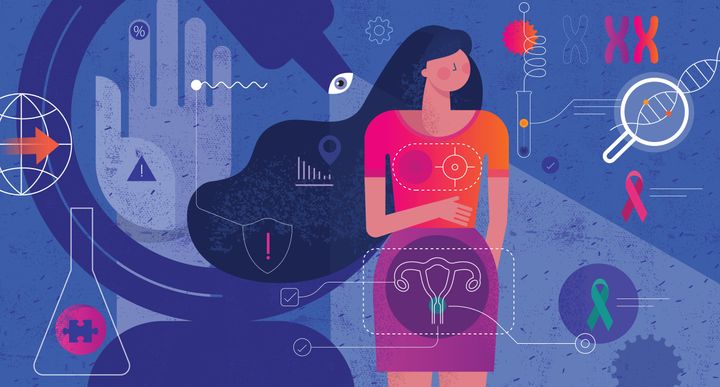
The gender health gap is a well-documented and widespread phenomenon, where women’s health concerns are regularly sidelined, neglected or dismissed.
To take just one stunning example, the British Heart Foundation explains that women 50% more likely to be misdiagnosed when suffering from a heart attack than men.
Twice as many women as men die from the underlying cause of heart attacks too – coronary heart disease.
Meanwhile, erectile dysfunction (which affects 19% of men) is studied in research five times more often than PMS, (which affects 90% of women), according to ResearchGate.
And endometriosis – where tissue like those which line the womb are found outside of the organ – can cause fertility issues, pain, fatigue and heavy bleeding as well as wellbeing issues. It takes an average eight years to be diagnosed.
Much of the issues come down to a lack of research and funding into women’s health.
The first ever plan to reduce these inequalities was only introduced last year in the government’s Women’s Health Strategy. It’s a start, but the examples mentioned above show we are still a long way off gender health equality.
So, what would life look like if women had the same healthcare as men? Women’s intimate health brand INTIMINA has produced a report imagining just that – and its findings are extraordinary.
1. Equal health would shrink the gender pay gap
The gender pay gap is an issue women still struggle with around the world. From November 22, the average woman in the UK is effectively working for free until the end of the year – that’s how large the discrepancy between women’s salaries and men’s salaries is.
As UK charity Fawcett Society notes, working women in the UK take home £574 less than men each month – that works out to £6,888 each year.
The charity calls for more flexible working in an effort to improve women’s pay.
But it’s also worth recognising that health plays a large role, too. A whopping 89% of people experienced stress or anxiety in the workplace because of their period.
INTIMINA points to research dating back to 2015, which claimed women in the UK take 17 million sick days a year because of PMS. A third of women also take at least four sick days a year.
More than a third reported heavy menstrual bleeding too, which has been connected to higher unemployment and workplace absences.
In fact, 2019 research from Standard Life shows women lose on average £5,469 each year in time off while waiting for an endometriosis diagnosis.
Research from BUPA found a million women dropped out of work because of unmanaged menopause symptoms.
If these conditions were better researched, addressed earlier and talked about more openly, it could reduce absenteeism in the workplace, INTIMINA suggested. Flexible working would help deal with these conditions, too.
2. Economic boost
If there was no gender health gap, It could save £18 billion a year, according to INTIMINA.
That’s because endometriosis costs the economy £8.2 billon a year through treatment, loss of work and healthcare costs.
Menopause costs £10 billion, and heavy, painful periods cost £531 million in sick days.
So it makes sense to invest in services to help treat these conditions.
And, according to the NHS Confederation, every pound invested in the NHS ends up giving £4 back to the economy by boosting productivity and workforce participation – truly, a win-win.
3. Boost for perinatal care
Healthcare professionals too often miss new mothers’ mental health struggles, the report revealed.
Research from 2021 suggested one in four new mothers weren’t asked about that side of their wellbeing during check-ups from doctors, with the focus often being on the newborn rather than the mum.
NHS England’s website also explains: “Perinatal mental health problems that are not treated effectively cost society £8.1 billion every year, with the annual cost to the NHS estimated at £1.2 billion.”
Suicide is the leading cause of maternal death during pregnancy and up to one year after it ends in the UK.
But as INTIMINA pointed out, many of the physical issues like incontinence or prolapse can be treated with early intervention and physiotherapy – which can help make new mothers’ lives a little easier.

4. Orgasm gap? Eradicated
Research from 2018 suggests women in lesbian relationships orgasm 86% of the time, and women in straight relationships 65% of the time.
For men, it’s 95% of the time in straight relationships and 89% of the time for gay men – meaning there is an orgasm gap.
Gynaecological cancer charity The Eve Appeal also found women are five times more likely to feel ignored when looking for medical help with reproductive health issues.
But, if women felt more comfortable getting to know their own bodies and speak to their doctors, INTIMINA suggested this would change.
Reduced pain, better mental health and better sex would all have knock-on effects for women’s relationships, too.
5. Women’s mental health improves
More research into conditions impacted by women – like PMS and Endometriosis – could offer a substantial boost to women’s mental health.
If endometriosis could be diagnosed after the first GP appointment – instead of after the average eight years – it would help relieve the 95% of patients who reported it had a negative impact on their wellbeing.
Women with polycystic ovary syndrome (PCOS) are three times more likely to have a mental health issue, while nearly half of those who suffer from premenstrual dysphoric disorder (PMDD) have planned for a suicide attempt at some point in their lives.
INTIMA claimed: “Earlier diagnosis and more effective treatments would help to reduce the mental health toll of menstrual and reproductive health issues. Symptoms would no longer be a barrier to living a full and well-rounded life.”
The brand suggested that, in turn, this would help reduce depression and anxiety among those who suffer.